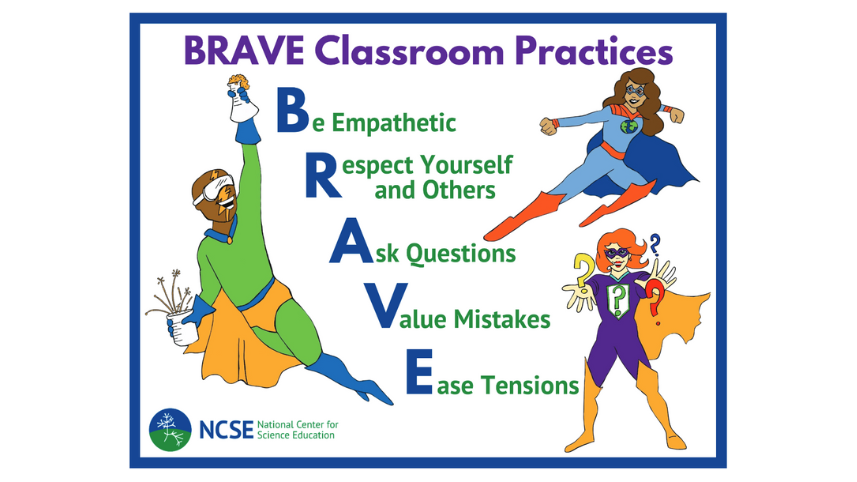NCSE's Approach to Managing Conflict in the Classroom
Being a public school science teacher in today’s society is very challenging. Many of the most important and relevant topics that we teach are fraught with social and political controversy. Because one of NCSE’s primary goals is to help resolve misconceptions and counter misinformation, it is crucial that teachers establish norms that will encourage students to participate in such a way that they will be willing to share their preconceptions of these topics and be open to new ideas. Being proactive and setting clear expectations for student behavior, guidelines for discussion, and habits of mind are essential for creating a healthy classroom culture where ideas can be expressed, challenged, and discussed.
NCSE’s vision for a healthy classroom culture is summarized with the acronym BRAVE: Be empathetic, Respect yourself and others, Ask questions, Value mistakes, and Ease tensions. To achieve a BRAVE classroom culture, the teacher must set ground rules early and students must practice them often. BRAVE sets expectations, but also gives students the tools to prepare for and participate in conversations that may be personally challenging.
Be empathetic: Try to put yourself in another person’s shoes and attempt to understand their feelings, ideas, and reasoning. We have more commonalities than differences. Find a place where you can start on equal footing and move forward together.
Respect yourself and others: Use kind language when engaging in discussions, answering questions, and presenting information. Think before you speak and consider how others will feel and be affected by your words and actions.
Ask questions: Always seek first to understand others’ perspectives and try not to judge or make assumptions. If something is unclear, ask for clarification or explanation so everyone is on the same page. Do this for scientific methods, data, and evidence, as well as opinions.
Value mistakes: An important part of science, and education more generally, is making mistakes and learning from them. If we aren’t making mistakes and reevaluating our thinking, then we aren’t engaging in science the way scientists do.
Ease tensions: Be aware of how situations are affecting your emotions and try to determine why. De-escalate misunderstandings and probe differences through questioning. It is perfectly acceptable to ask for clarification and to set boundaries for discussions where necessary.
BRAVE classrooms vs. safe spaces
NCSE’s vision of a BRAVE classroom is specific to scientific inquiry and differs from the historic concept of a safe space. The idea of safe spaces in educational and professional settings dates back to the 1970s and has become more prominent in recent decades because of Diversity, Equity, and Inclusion (DEI) initiatives.1 However, although educators are responsible for protecting their students' physical and emotional well-being, safety is often conflated with comfort when discussing safe spaces in education. Some even go so far as to define safe spaces as being “free from harm or risk … affording safety or security from danger, risk, or difficulty … unlikely to produce controversy or contradiction.”2 Not only are these concepts of safe spaces impossible to produce in a classroom of diverse students with diverse backgrounds and ideas, but even if it were possible, this concept is counterproductive to education which involves “not only risk, but the pain of giving up a former condition in favor of a new way of seeing things.”3
For example, when engaging in an argument from evidence, it is impossible to create a space where students are unlikely to experience “controversy or contradiction,” not to mention the variety of beliefs, ideologies, preconceptions, and misconceptions students may bring into the classroom. Our role as educators, therefore, is to create a brave space where we can balance contradictions to a student’s current way of thinking with positive encouragement to explore new ways of understanding scientific topics. To do this, students need to know that if an authentic exchange of ideas is to take place, they will need to “risk honesty,” be vulnerable, and be prepared to encounter new ideas that might cause discomfort.
Although we distinguish between BRAVE classrooms and safe spaces, we still believe teachers should work to make their
classrooms feel safe for students. BRAVE helps us navigate socially and politically controversial science ideas and resolve common student misconceptions, but students’ cultures and identities should never be disregarded or devalued. It is important for teachers to recognize that certain students may be triggered by scientific argumentation and to allow students to use coping strategies to manage their emotions and protect themselves.
Download this article as a PDF.
Download a BRAVE classroom poster [PDF].
1 Barrett, B. J. (2010). Is" Safety" Dangerous? A Critical Examination of the Classroom as Safe Space. Canadian Journal for the Scholarship of Teaching and Learning, 1(1), 9.
2 Arao, B., & Clemens, K. (2013). From safe spaces to brave spaces. The art of effective facilitation: Reflections from social justice educators, 135, 150.
3 Boostrom, R. (1998). ‘‘Safe spaces’’: Reflections on an educational metaphor. Journal of Curriculum Studies, 30(4), 397–408.

